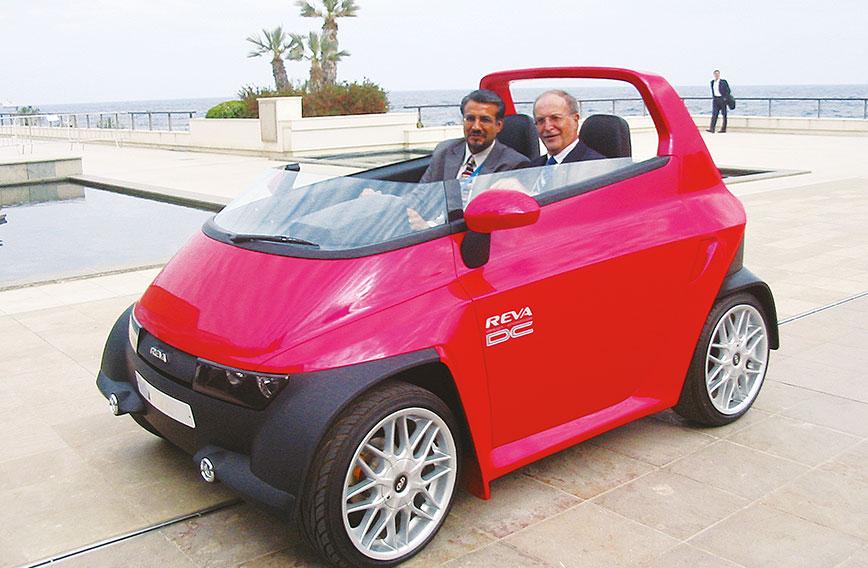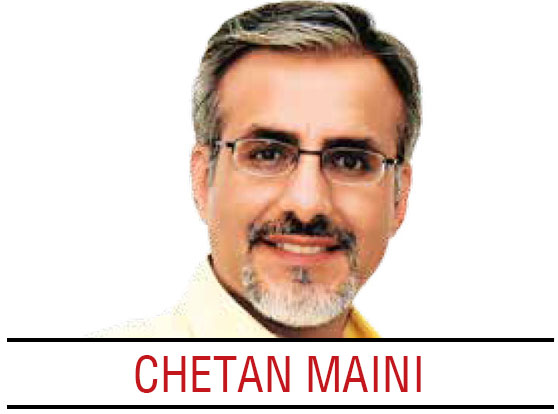
In India people started taking Reva seriously only when it was exported to countries like Norway and the UK
Building the Reva meant starting from scratch
 The idea of electric vehicles to clean up the air in our cities has always been the right one. Back in 2001, however, when I first launched Reva, India’s first mass-produced electric car, it seemed like it was ahead of its time. While we sold the car in 24 countries and created a certain level of awareness, the reduction in pollution and energy was not as impactful as I would have liked it to be. As I reflect on my journey as an entrepreneur and an agent of change, introducing a transformational technology, I have always been driven by this vision of a future when people commute with a mass transport solution powered by renewables — enabling a cleaner, less polluted world.
The idea of electric vehicles to clean up the air in our cities has always been the right one. Back in 2001, however, when I first launched Reva, India’s first mass-produced electric car, it seemed like it was ahead of its time. While we sold the car in 24 countries and created a certain level of awareness, the reduction in pollution and energy was not as impactful as I would have liked it to be. As I reflect on my journey as an entrepreneur and an agent of change, introducing a transformational technology, I have always been driven by this vision of a future when people commute with a mass transport solution powered by renewables — enabling a cleaner, less polluted world.
My tryst with clean mobility goes back to 1990 when I was just 20 years old, at the University of Michigan. Always hooked on cars, I had the opportunity to participate in a 2,500-km race across the US in a car we built, called the SUN Runner, that was solely powered by solar energy. We were fortunate to come first in this race which led to General Motors sponsoring us for the 1990 World Solar Challenge in Australia.
Again, we raced for 3,000 km across the vast Australian outback and came third, right behind Honda. Being able to cross a continent on just energy from the sun was an eye-opener for me. Oil prices were at an all-time low and there was little awareness of climate change. Electric vehicles (EVs) were really not on anyone’s agenda.
On my summer holiday trips back home to Bengaluru I saw the city grappling with the challenges of pollution, congestion and transportation. Solar cars were very expensive, so
it was clear that a more practical solution was required. It was then that the idea took root in
me that electric vehicles using renewables could transform the world and be the much-needed solution for developing countries like India and China.
In the late 1990s, when I started to build the Reva, the situation was very different from what is happening today. There was lack of a supportive ecosystem. I am not just talking about funding. There was lack of a regulatory framework to certify vehicles. There was no clear government policy to work on. The VC (venture capitalist) community was not keen to invest in products since India was more into services, especially in the field of software. Moreover, suppliers were unsure about coming on board because they were concerned about the future of electric mobility. It was also difficult to get banks or insurance companies to consider supporting customers who purchased electric vehicles as they did not know how to finance such a product, in terms of value, depreciation, and so on.
Finding talent was also an issue. In fact, not a single person we hired initially had ever worked on an electric vehicle before. This required us to train engineers and build teams for R&D, testing, manufacturing and service, in addition to setting up supportive infrastructure. We had to focus on not just addressing the challenges in developing cutting-edge technology, a lot of our energy went into creating an ecosystem and communicating across ecosystems. We had to ensure people understood how electric vehicles were going to impact society, pollution, the economy and the country.
Changing perceptions and attitudes about electric cars was equally important. Nobody had any idea about electric vehicles and they often wanted to know if something like this was run anywhere in the world before they would commit to it — be it a financier or a customer. People started taking us seriously only after the Reva was exported to countries such as Norway and the UK!
As Indians, we need to start seeing our differentiation and innovation in a more positive light and believe that we can also lead in such new areas.
Today, the EV landscape has gone through a huge makeover. Globally, EVs are growing at the rate of 60 percent year-on-year, propelled by climate change mitigation goals. The environment too is conducive for the adoption of EVs. Renewable energy prices are falling; battery technology has advanced, battery costs have dropped, and there are compelling reasons today to bring down our pollution and oil import bills. Consumers are also more aware and keen to look at electric mobility. All these conditions are coming together in an area where we can connect the dots and consider viable sustainable options.
Today, we also have more than 100 start-ups emerging in the electric vehicle space, attracting investments to the tune of millions of dollars. The Indian government is pushing for electric vehicles. State governments have started releasing their own policies. Subsidies and tax benefits around EVs and battery manufacturing exist. Finance and insurance companies understand EVs better as they have seen them running for 15 years. The supply chains for EV components are globally available and
slowly building in India. There is a clear framework to certify vehicles. Investments in charging infrastructure are slowly happening. Customer adoption is also on the increase.
Shared mobility companies are introducing electric vehicles in fleets. Ola, Lithium, Smart-E have successfully deployed hundreds of electric vehicles. The government too has triggered demand by ordering 10,000 electric cars and around 500 electric buses. So, entrepreneurs today are operating in a more encouraging environment. Young companies can now focus a lot more on developing their products and solutions and reduce their time on marketing. They need to spend less effort in building an ecosystem. This is really going to help the EV revolution in the country and enable start-ups to be a huge part of this story.
In many ways, the seeds of SUN Mobility were sown when trying to run cars on solar energy back in the 1990s. After selling the Reva to Mahindra, I reflected on the barriers that were preventing mass adoption of electric vehicles. The key concerns for consumers were high acquisition cost (primarily driven by the cost of batteries), range anxiety (limited driving distance) and long refuelling time.
Electric vehicles require five to eight hours for a normal charge or an hour for a fast charge. But, for a consumer used to a re-fuelling time of five minutes, anything more than that seems like eternity. The idea was to create a business model and a set of technologies that could truly address these challenges. By separating the batteries (and auxiliary systems like chargers) from electric vehicles, EVs could be priced similar to petrol vehicles and by integrating the energy and battery into a “pay as you go model” for customers, one could also get the cost of energy per kilometre to be lower than for gasoline. With customers being able to swap these batteries in a couple of minutes (faster than re-fuelling gasoline), one could address the issues of range anxiety and long refuelling time.
It was around this time that I reconnected with Uday Khemka, who is a strong advocate of combatting climate change and was setting up new businesses in renewable energy. Uday came from the renewable world and I from electric mobility, but we had a common vision to create a cleaner and sustainable future. We reflected on how just a small, exclusive population in the world was able to go green since it was an expensive proposition and how battery swapping could potentially change this.
Next, we looked at what would have the biggest impact on society. We realised that around 45 percent of people in a city like Bengaluru travel by bus and another 45 percent use two and three-wheelers. While the world’s focus has been on developing electric cars for personal mobility, we decided to focus on public transport, shared mobility and two-wheelers. These vehicles are driven the most and create the maximum pollution.
SUN Mobility can impact over 80 percent of mobility in India. It is an Indian solution that can be globally deployed. Our smart mobility solution involves an interoperable energy infrastructure platform that will help accelerate adoption of EVs. Our solution is designed to scale and to provide a cost-benefit outcome to the customer and therefore can create a meaningful impact on civil society and the environment.
We need solutions fast because of rapid environmental decline in India. Our dependence on fossil fuels is also cause for concern. Another reason for pressing the green button is jobs: the renewables sector provides employment.
India has the opportunity to create a global differentiation and lead this transformation in mobility. Currently, we are looking at this conversion as a challenge, impacting jobs in the auto industry. But we need to consider the larger picture. After all, we have the right skills sets — we have led in small cars, electronics manufacturing and IT software. And, we have an expanding entrepreneur community full of zeal to change society.
Our renewable energy reserves are increasing rapidly with strong government backing. India is all set to achieve its target of installing 175 GW of renewable energy by 2022, on the back of new schemes like floating solar, manufacturing-linked solar, and offshore wind projects. Solar energy makes up 100 GW of this target. To put this in perspective, if all the 30 million vehicles produced in India in 2022 were electric, we would need only 25 GW of solar energy to power them, just 25 percent of the target that India is planning. Running mobility on renewable energy is no longer a scenario of the future, but a reality.
The auto industry is over 7 percent of our GDP and will go through major transformation as we go electric. New investments will be required that will create new jobs in the supply chain, in manufacturing and infrastructure. This will further augment the jobs created by renewable energy that will power electric mobility. By building the ecosystem in India we also have a large opportunity to become an EV export hub globally.
The current question is: given the right climate, resources and policy interventions, how do we integrate these agents of change into the ecosystem?
It is important, first of all, to create the right ecosystem, one that will include energy providers, mobility solution providers, OEMs (original equipment manufacturers), suppliers, policy bodies and so on — all coming together to drive this transformation.
We should not forget to integrate start-ups as we go along. If we create the right ecosystem, entrepreneurs will innovate and flourish.
In this big transformation, the government has a role to play — first, of providing the vision. India is ready to lead, but there needs to be a larger vision, which is beyond individuals and organisations. Along with vision, we need a set of policies to enable clean energy transportation. The automobile industry, growing at 9 percent, provides a great opportunity for us to pivot it and move towards creating a new India that is cleaner, green and safer.
Comments
-

Manik Hiranandani - April 23, 2022, 9:40 p.m.
Great Article Chetan.Would Be nice If you could update it & give us a Vision of How the EV space looks like today



